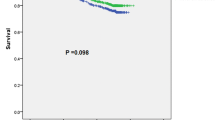Abstract
The purpose of the article was to assess whether smoking affects survival in male breast cancer patients for the overall population and when stratified by race, ethnicity, and socioeconomic status. Data were obtained by linking the 1996–2007 Florida Cancer Data System, the Florida Agency for Health Care Administration, and the US Census. Inclusion criteria were males ≥18 years, diagnosed with breast cancer and residing in Florida (n = 1573). To analyze the association between smoking and survival, we performed sequential multivariate Cox proportional hazards regression models with progressive adjustment for main confounders. Compared to never smokers, worse survival was found in current (hazard ratio = 1.63; 95 % CI = 1.23–2.16) but not in former smokers (1.26; 0.99–1.59). Those who smoked ≥1 packs/day had worse survival (2.48; 1.59–3.87) than never smokers with a significant dose–response (P for linear trend <0.001). Race-ethnic stratified models comparing current and former smokers with never smokers found significant differences among Whites [(1.88; 1.44–2.44) and (1.31; 1.04–1.65, respectively)] and non-Hispanics, [(1.73; 1.31–2.28) and (1.31; 1.04–1.66, respectively)]. Overall, current smokers were found to have significantly reduced survival, which was worse by intensity of smoking. Also, any smoking history is associated with worse survival in White and non-Hispanic male breast cancer patients compared to never smokers. Thus, male breast cancer patients should be advised to quit smoking.
Similar content being viewed by others
Abbreviations
- SES:
-
Socioeconomic status
- FCDS:
-
Florida Cancer Data System
- AHCA:
-
Agency for health care administration
- HR:
-
Hazard ratio
- CI:
-
Confidence interval
- CA:
-
Carcinoma
References
Ewertz M, Holmberg L, Tretli S, Pedersen BV, Kristensen A (2001) Risk factors for male breast cancer—a case–control study from Scandinavia. Acta Oncol 40(4):467–471
Hsing AW, McLaughlin JK, Cocco P, Co Chien HT, Fraumeni JF Jr (1998) Risk factors for male breast cancer (United States). Cancer Causes Control 9(3):269–275
US Department of health and human services (2014) The health consequences of smoking. 50 years of progress: a report of the surgeon general. http://www.cdc.gov/tobacco/data_statistics/sgr/50th-anniversary/index.htm#report. Accessed 10 Oct 2014
US Department of Health and Human Services, Centers for Disease Control and Prevention and National Cancer Institute U.S. Cancer Statistics Working Group (2014) United States Cancer Statistics: 1999–2011 incidence and mortality web-based report. www.cdc.gov/uscs. Accessed 28 Feb 2015
Tannenbaum SL, Koru-Sengul T, Miao F, Byrne MM (2013) Disparities in survival after female breast cancer diagnosis: a population-based study. Cancer Causes Control 24(9):1705–1715. doi:10.1007/s10552-013-0246-5
Anderson WF, Althuis MD, Brinton LA, Devesa SS (2004) Is male breast cancer similar or different than female breast cancer? Breast Cancer Res Treat 83(1):77–86
Padron-Monedero A, Tannenbaum SL, Koru-Sengul T, Miao F, Hansra D, Lee DJ, Byrne MM (2015) Smoking and survival in female breast cancer patients. Breast Cancer Res Treat 150(2):395–403. doi:10.1007/s10549-015-3317-3
Boscoe FP, Sherman C (2006) On socioeconomic gradients in cancer registry data quality (letter). J Epidermiol Community Health 60:551
Elixhauser A, Steiner C, Harris DR, Coffey RM (1998) Comorbidity measures for use with administrative data. Med Care 36(1):8–27
Calle EE, Miracle-McMahill HL, Thun MJ, Heath CW (1994) Cigarette smoking and risk of fatal breast cancer. Am J Epidemiol 139(10):1001–1007
Holmes MD, Murin S, Chen WY, Kroenke CH, Spiegelman D, Colditz GA (2007) Smoking and survival after breast cancer diagnosis. Int J Cancer 120(12):2672–2677
Hellmann SS, Thygesen LC, Tolstrup JS, Gronbaek M (2010) Modifiable risk factors and survival in women diagnosed with primary breast cancer: results from a prospective cohort study. Eur J Cancer Prev 19(5):366–373. doi:10.1097/CEJ.0b013e32833b4828
Manjer J, Andersson I, Berglund G, Bondesson L, Garne JP, Janzon L, Malina J, Matson S (2000) Survival of women with breast cancer in relation to smoking. Eur J Surg 166(11):852–858
Yu GP, Ostroff JS, Zhang ZF, Tang J, Schantz SP (1997) Smoking history and cancer patient survival: a hospital cancer registry study. Cancer Detect Prev 21(6):497–509
Wojcik BE, Spinks MK, Optenberg SA (1998) Breast carcinoma survival analysis for African American and white women in an equal-access health care system. Cancer 82(7):1310–1318
Land LH, Dalton SO, Jorgensen TL, Ewertz M (2012) Comorbidity and survival after early breast cancer. A review. Crit Rev Oncol Hematol 81(2):196–205. doi:10.1016/j.critrevonc.2011.03.001
Satariano WA (1993) Aging, comorbidity, and breast cancer survival: an epidemiologic view. Adv Exp Med Biol 330:1–11
Daniell HW (1988) Increased lymph node metastases at mastectomy for breast cancer associated with host obesity, cigarette smoking, age, and large tumor size. Cancer 62(2):429–435
Zang EA, Wynder EL (1996) Differences in lung cancer risk between men and women: examination of the evidence. J Natl Cancer Inst 88:183–192
Woodward M, Tunstall-Pedoe H (1992) Biochemical evidence of persistent heavy smoking after a coronary diagnosis despite self-reported reduction: analysis from the Scottish Heart Health Study. Eur Heart J 13(2):160–165
Sherman RL, Boscoe FP, O’Brien DK, George JT, Henry KA, Soloway LE, Lee DJ (2014) Misclassification of sex in central cancer registries. J Registry Manag 41(3):120–124
Acknowledgments
This study was funded by the James & Esther King Florida Biomedical Research Program (Grant 10KG-06).
Author information
Authors and Affiliations
Corresponding author
Ethics declarations
Conflict of interest
The authors declare that they have no conflict of interest.
Ethical approval
This manuscript complies with the current laws of the country in which the research was performed. The study was approved by the Institutional Review Boards of the University of Miami and the Florida Department of Health in the US, and has been performed in accordance with the ethical standards as laid down in the 1964 Declaration of Helsinki and its later amendments or comparable ethical standards.
Informed consent
For this type of study formal consent is not required.
Rights and permissions
About this article
Cite this article
Padron-Monedero, A., Koru-Sengul, T., Tannenbaum, S.L. et al. Smoking and survival in male breast cancer patients. Breast Cancer Res Treat 153, 679–687 (2015). https://doi.org/10.1007/s10549-015-3582-1
Received:
Accepted:
Published:
Issue Date:
DOI: https://doi.org/10.1007/s10549-015-3582-1




